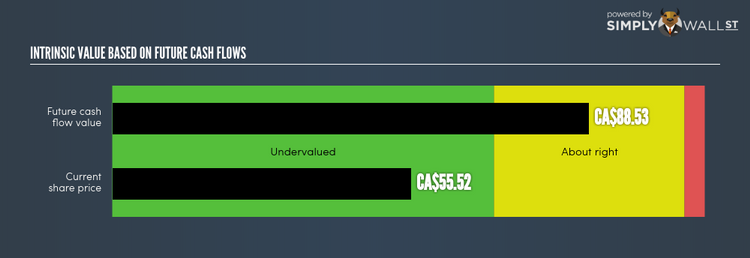Is There An Opportunity With Equitable Group Inc’s (TSE:EQB) Mispricing?

EQB operates in the thrifts mortgage finance industry, which has characteristics that make it unique compared to other sectors. Understanding these differences is crucial when it comes to putting a value on these financial stocks. For instance, these lenders must hold a certain level of cash reserves on the books as a safety precaution. Examining factors such as book values, with the return and cost of equity, may be beneficial for computing EQB’s intrinsic value. Today I’ll look at how to value EQB in a reasonably accurate and simple way. View our latest analysis for Equitable Group
What Is The Excess Return Model?
Before we begin, remember that financial stocks differ in terms of regulation and balance sheet composition. The regulatory environment in Canada is fairly rigorous. Moreover, mortgage and thrift companies tend to not hold large portions of physical assets on their balance sheet. So the Excess Returns model is suitable for determining the intrinsic value of EQB rather than the traditional discounted cash flow model, which places emphasis on factors such as depreciation and capex.
The Calculation
The key belief for this model is, the value of the company is how much money it can generate from its current level of equity capital, in excess of the cost of that capital. The returns above the cost of equity is known as excess returns:
Excess Return Per Share = (Stable Return On Equity – Cost Of Equity) (Book Value Of Equity Per Share)
= (13.78% – 12.32%) * CA$77.43 = CA$1.13
We use this value to calculate the terminal value of the company, which is how much we expect the company to continue to earn every year, forever. This is a common component of discounted cash flow models:
Terminal Value Per Share = Excess Return Per Share / (Cost of Equity – Expected Growth Rate)
= CA$1.13 / (12.32% – 2.13%) = CA$11.1
Combining these components gives us EQB’s intrinsic value per share:
Value Per Share = Book Value of Equity Per Share + Terminal Value Per Share
= CA$77.43 + CA$11.1 = CA$88.53
Relative to today’s price of CA$55.52, EQB is priced beneath its true value. Therefore, there is potential room to profit from mispricing if you bought EQB at CA$88.53. Pricing is one part of the analysis of your potential investment in EQB. Analyzing fundamental factors are equally important when it comes to determining if EQB has a place in your holdings.
Next Steps:
For mortgage and thrift companies, there are three key aspects you should look at:
Financial health: Does it have a healthy balance sheet? Take a look at our free bank analysis with six simple checks on things like bad loans and customer deposits.
Future earnings: What does the market think of EQB going forward? Our analyst growth expectation chart helps visualize EQB’s growth potential over the upcoming years.
Dividends: Most people buy financial stocks for their healthy and stable dividends. Check out whether EQB is a dividend Rockstar with our historical and future dividend analysis.
For more details and sources, take a look at our full calculation on EQB here.
To help readers see pass the short term volatility of the financial market, we aim to bring you a long-term focused research analysis purely driven by fundamental data. Note that our analysis does not factor in the latest price sensitive company announcements.
The author is an independent contributor and at the time of publication had no position in the stocks mentioned.

